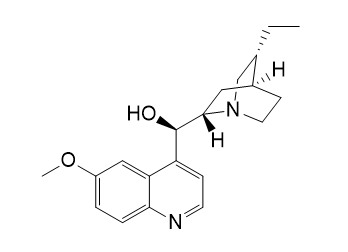Dihydroquinine
Dihydroquinine has equivalent antimalarial activity.
Inquire / Order:
manager@chemfaces.com
Technical Inquiries:
service@chemfaces.com
Tel:
+86-27-84237783
Fax:
+86-27-84254680
Address:
1 Building, No. 83, CheCheng Rd., Wuhan Economic and Technological Development Zone, Wuhan, Hubei 430056, PRC
Providing storage is as stated on the product vial and the vial is kept tightly sealed, the product can be stored for up to
24 months(2-8C).
Wherever possible, you should prepare and use solutions on the same day. However, if you need to make up stock solutions in advance, we recommend that you store the solution as aliquots in tightly sealed vials at -20C. Generally, these will be useable for up to two weeks. Before use, and prior to opening the vial we recommend that you allow your product to equilibrate to room temperature for at least 1 hour.
Need more advice on solubility, usage and handling? Please email to: service@chemfaces.com
The packaging of the product may have turned upside down during transportation, resulting in the natural compounds adhering to the neck or cap of the vial. take the vial out of its packaging and gently shake to let the compounds fall to the bottom of the vial. for liquid products, centrifuge at 200-500 RPM to gather the liquid at the bottom of the vial. try to avoid loss or contamination during handling.
Mol Neurobiol.2023, 60(12):7196-7207.
Nutrients2022, 14(3),695.
J Chem Inf Model.2021, 61(11):5708-5718.
Toxicological Research2020, doi: 10.1007.
Food Science&Tech. Res.2022, 28(2):123-132.
Appl. Sci.2020, 10,1304
Environ Toxicol.2019, 34(12):1354-1362
Redox Biology2024, 103197.
Nutrients.2018, 10(12)
Int J Biol Macromol.2020, 161:1230-1239.
Related and Featured Products
Transactions of the Royal Society of Tropical Medicine & Hygiene, 1996,164(2):380-6.
Antimalarial activity and interactions between quinine, dihydroquinine and 3-hydroxyquinine against Plasmodium falciparum in vitro.[Reference:
WebLink]
METHODS AND RESULTS:
The antimalarial activities of quinine, Dihydroquinine (a natural impurity found in commercial pharmaceutical formulations of quinine) and 3-hydroxyquinine (the principal metabolite of quinine in humans) were tested both individually and in pairs against 5 strains of Plasmodium falciparum isolated from patients in Thailand. The median inhibitory concentrations (IC50) were similar for quinine (168 nmol/L, range 68–366), and Dihydroquinine (129 nmol/L, range 54–324), and both were significantly lower than that of 3-hydroxyquinine (1160 nmol/L, range 378–3154) (P = 0·027). When these drugs were tested in combination, there was no evidence of synergy or antagonism, as determined by fractionary inhibitory indices and isobolograms.
CONCLUSIONS:
Quinine and its impurity, Dihydroquinine, have equivalent antimalarial activities which are approximately 10 times greater than that of the metabolite 3-hydroxyquinine. These 2 compounds, which are not usually measured in specific drug assays, contribute to antimalarial activity after quinine administration.



